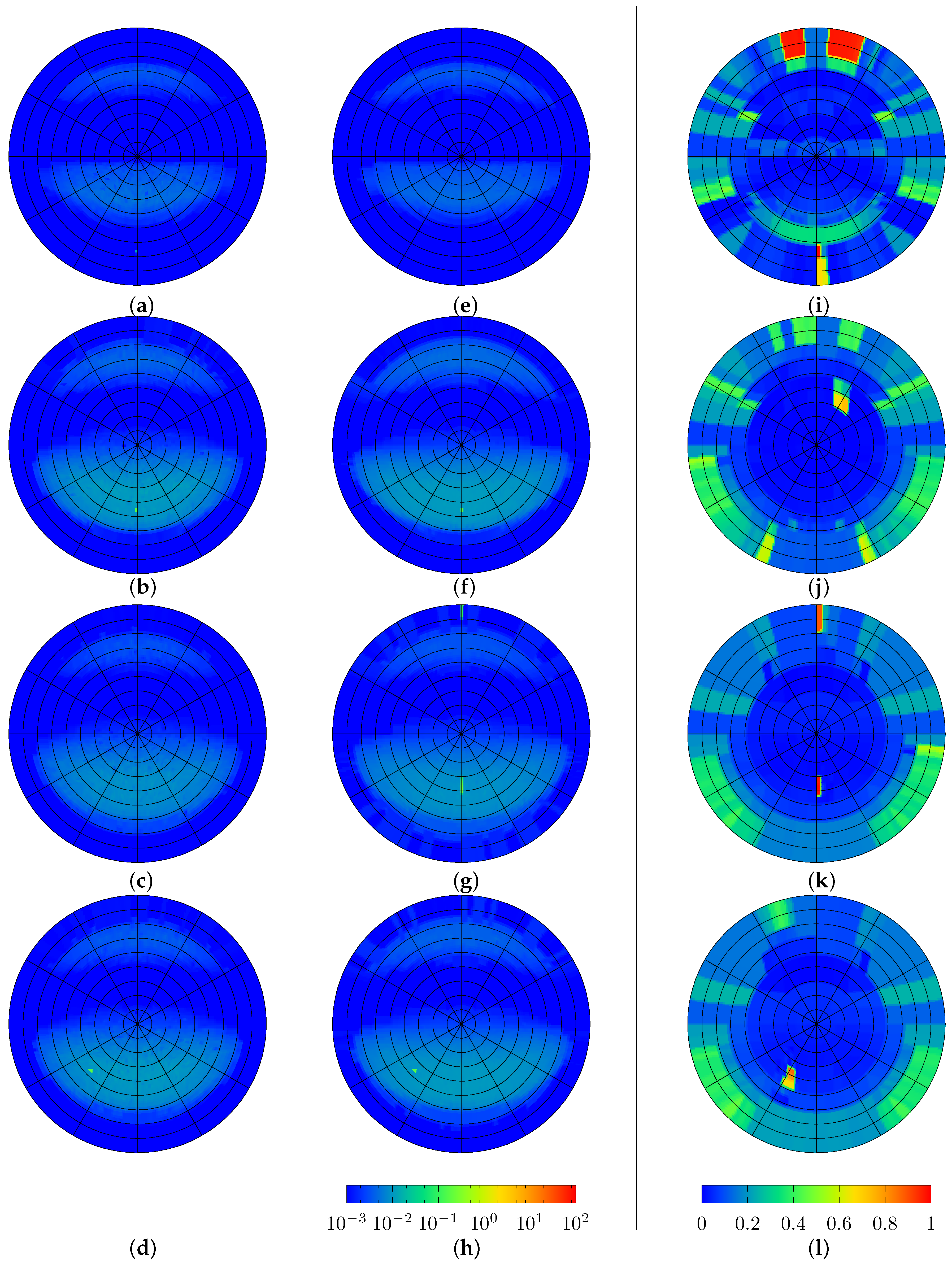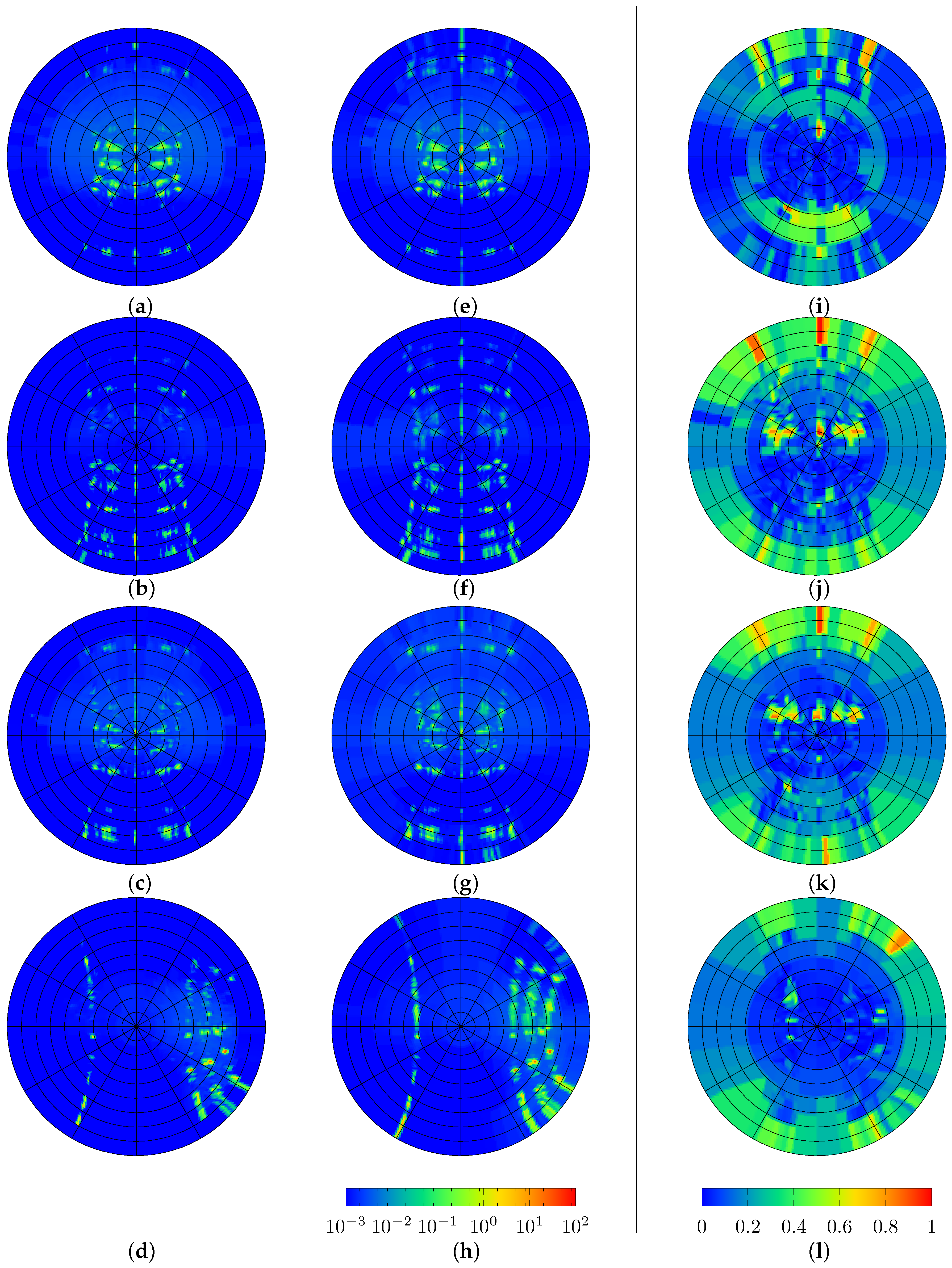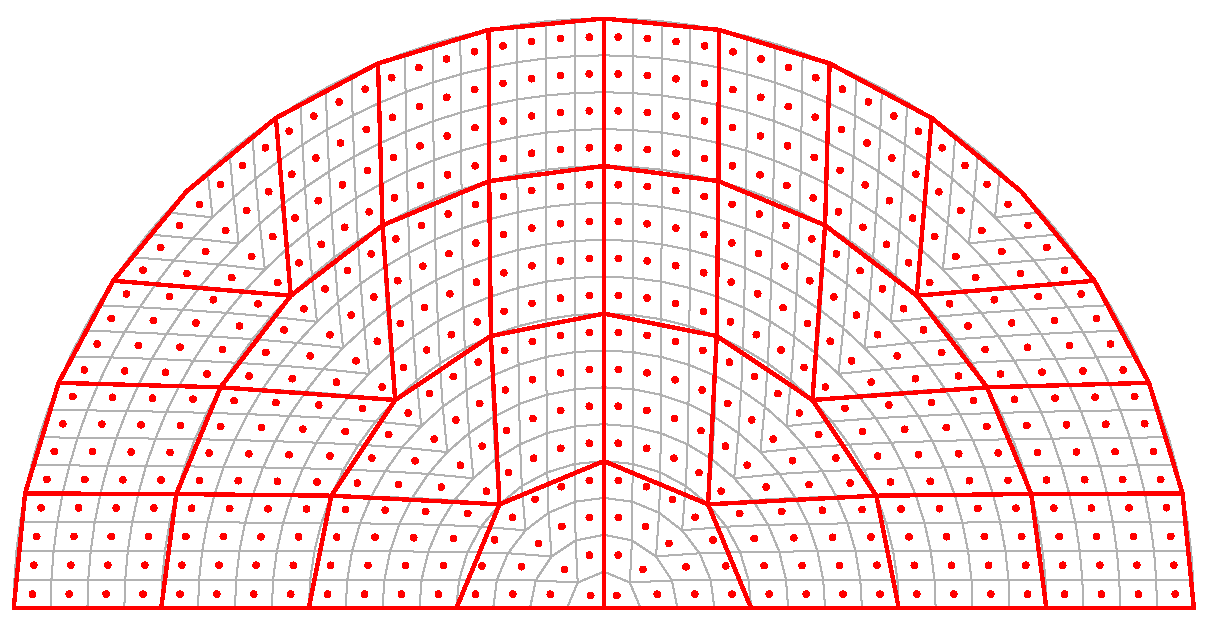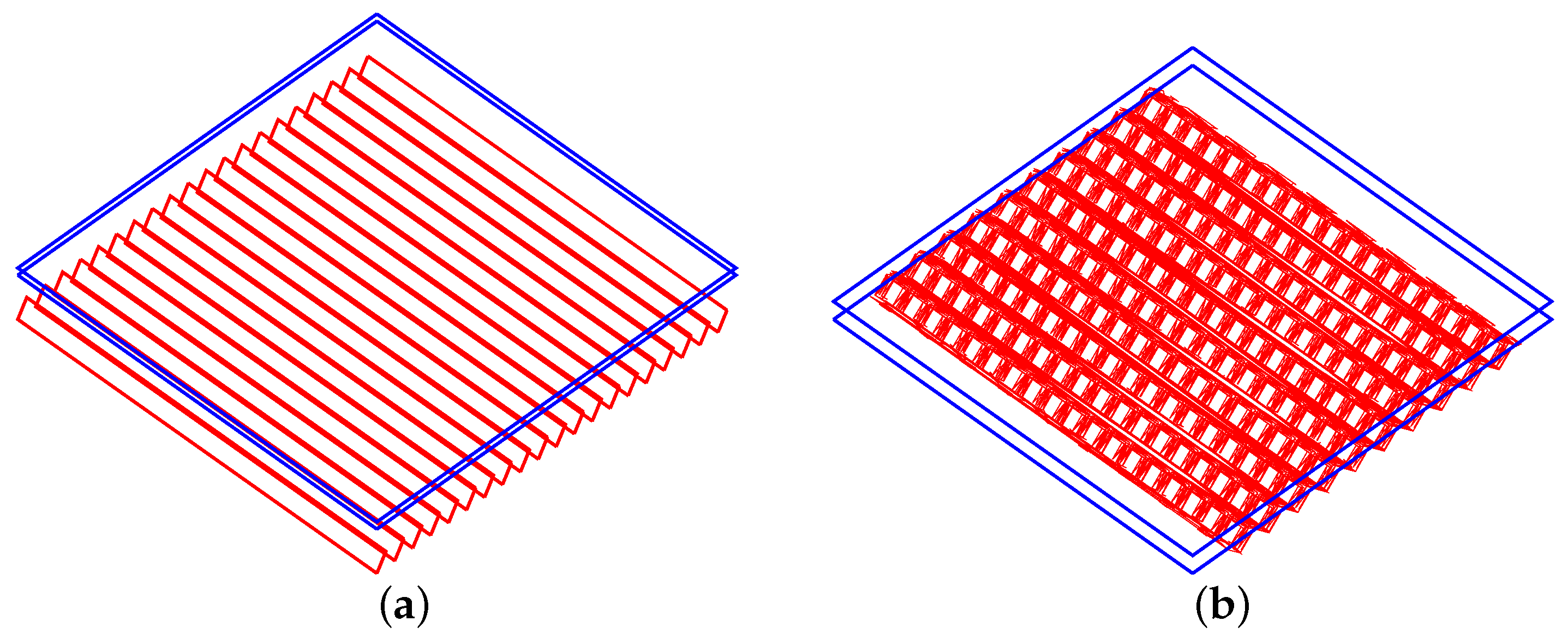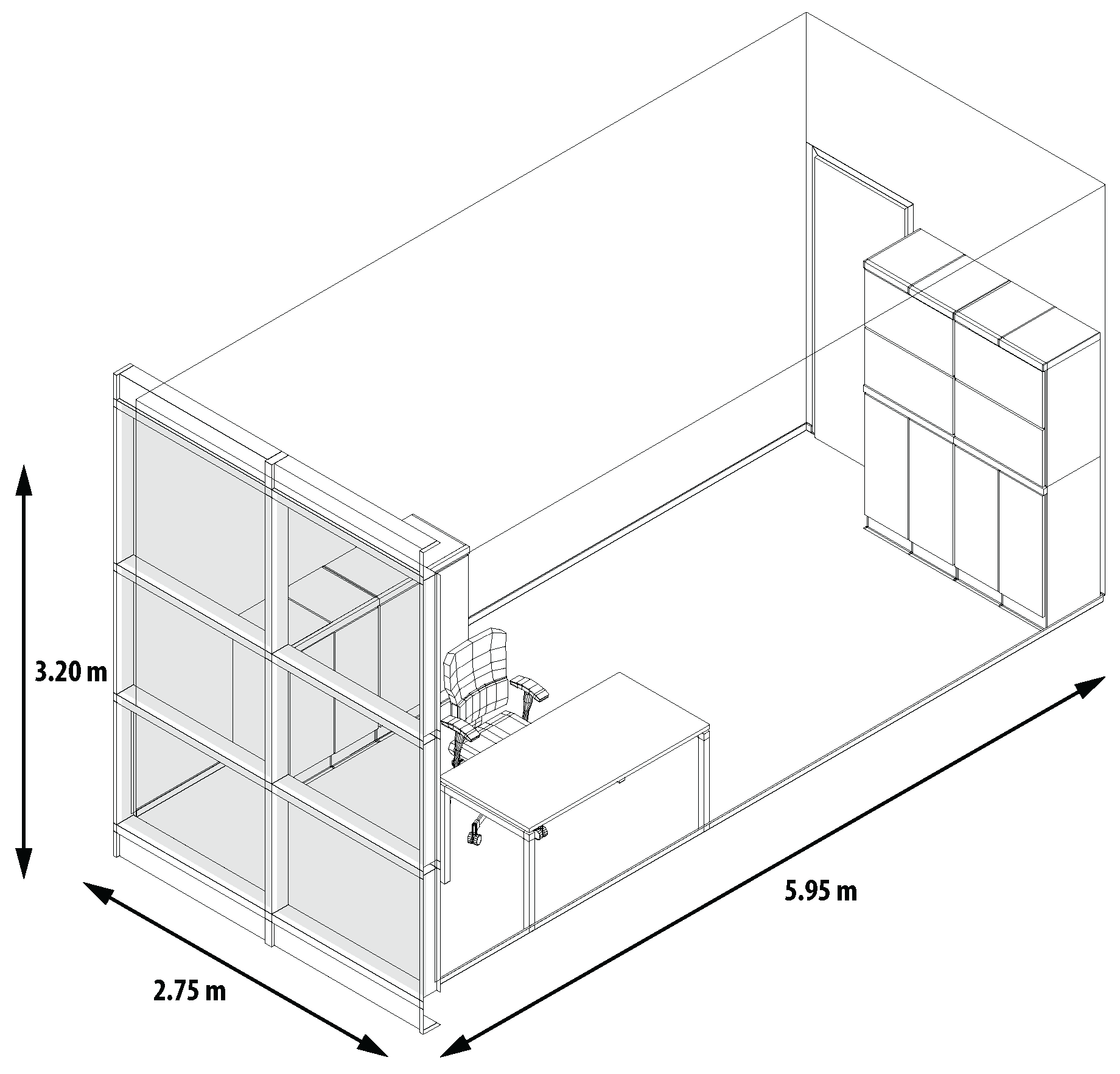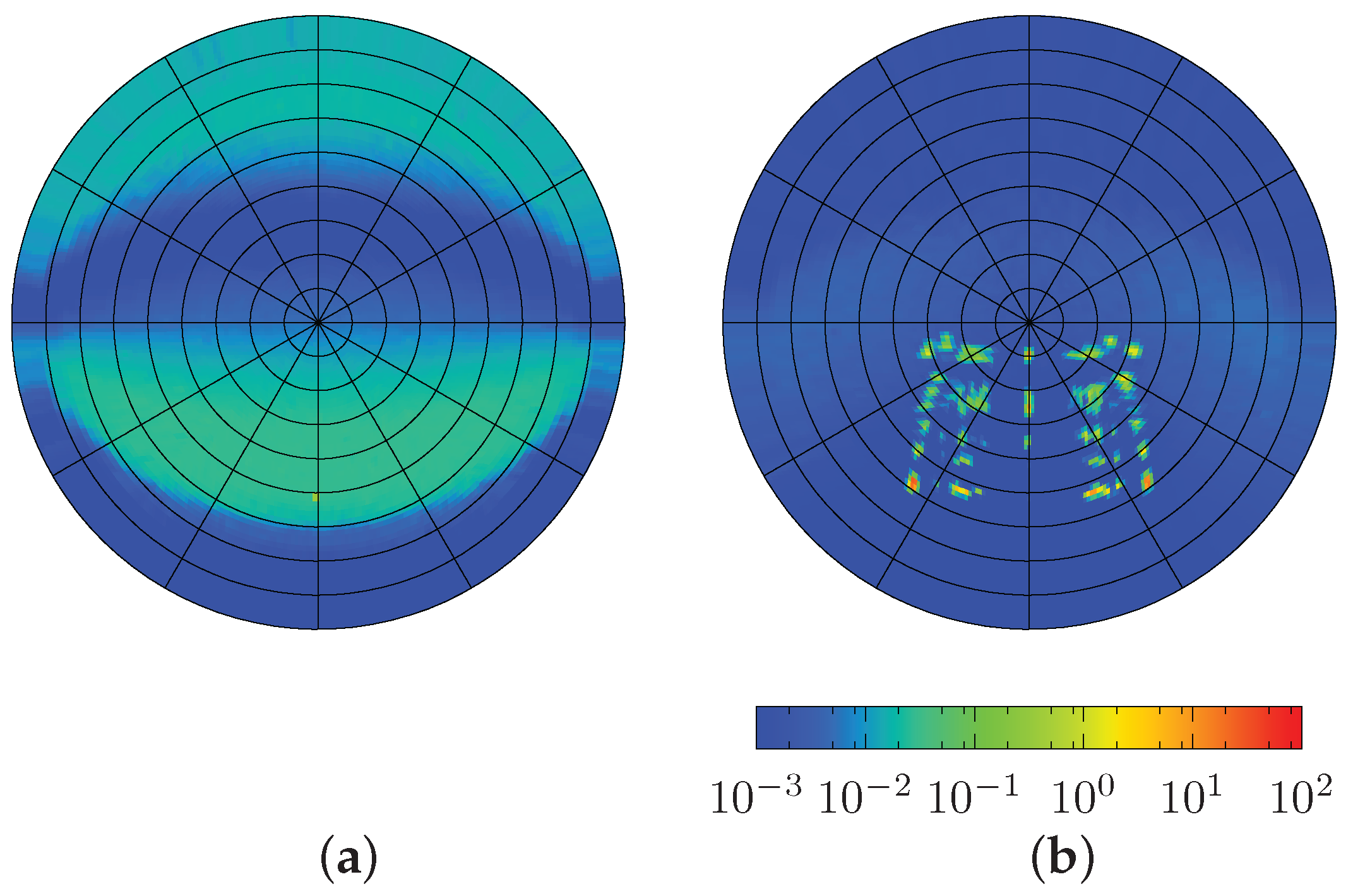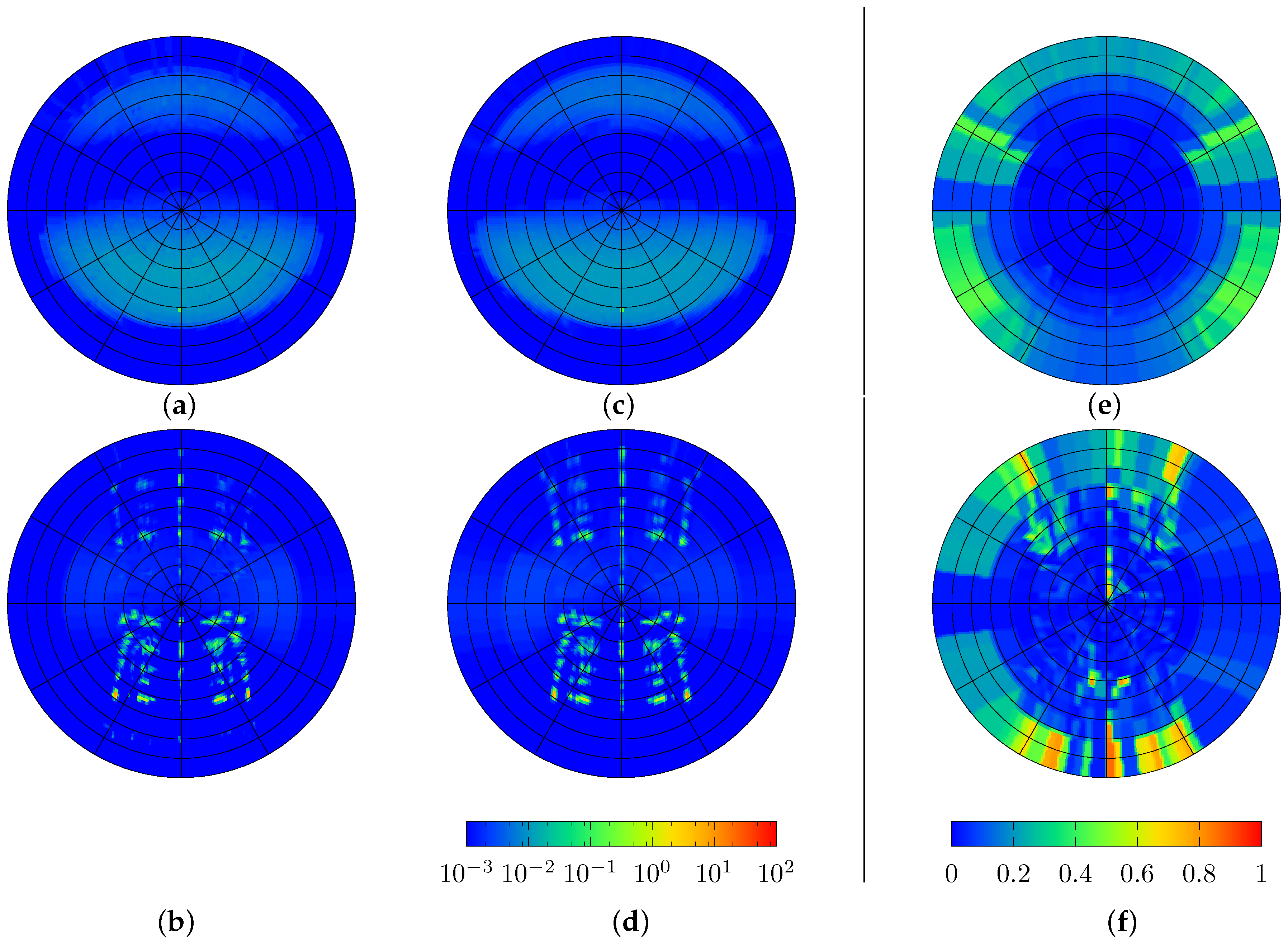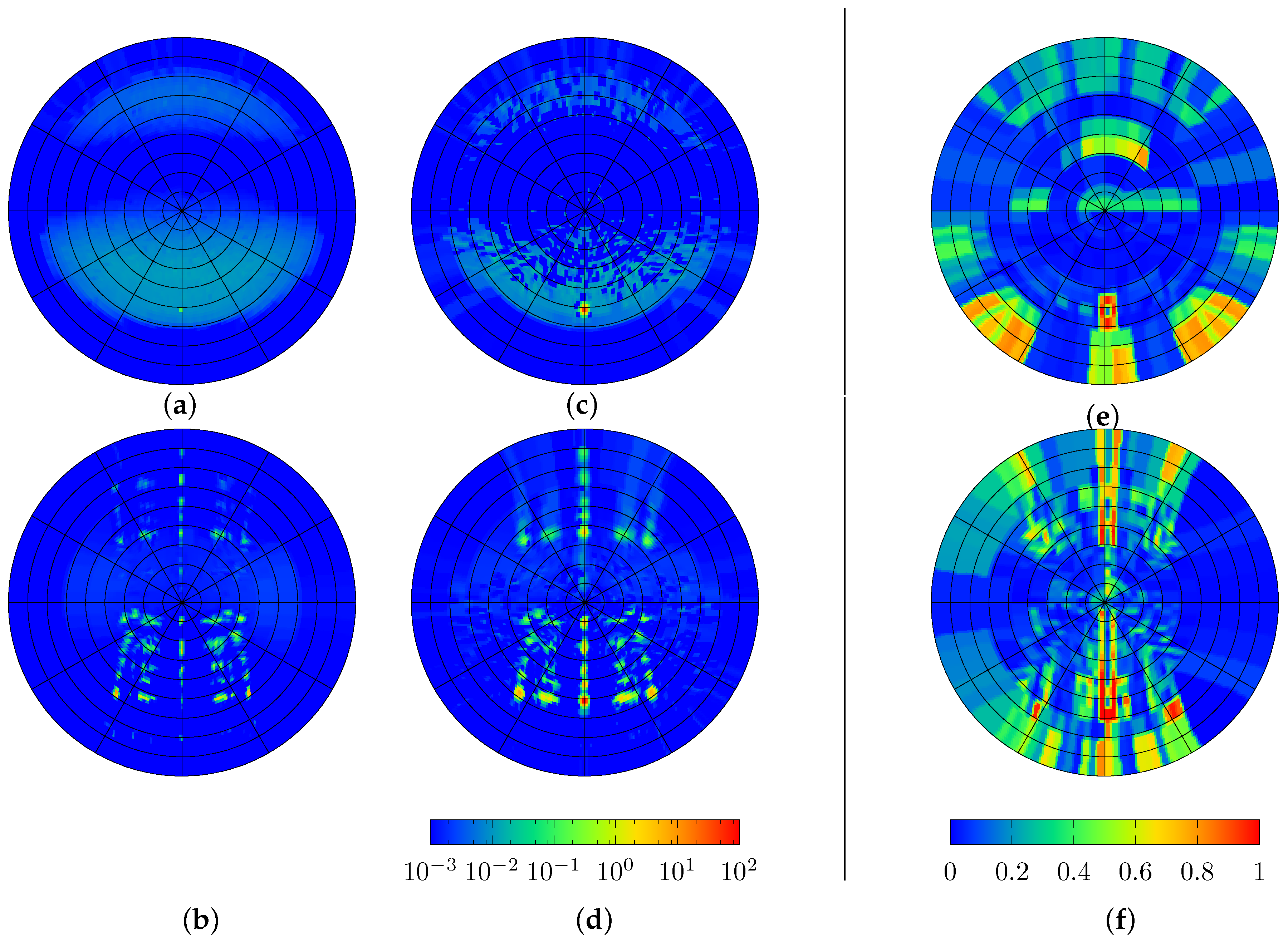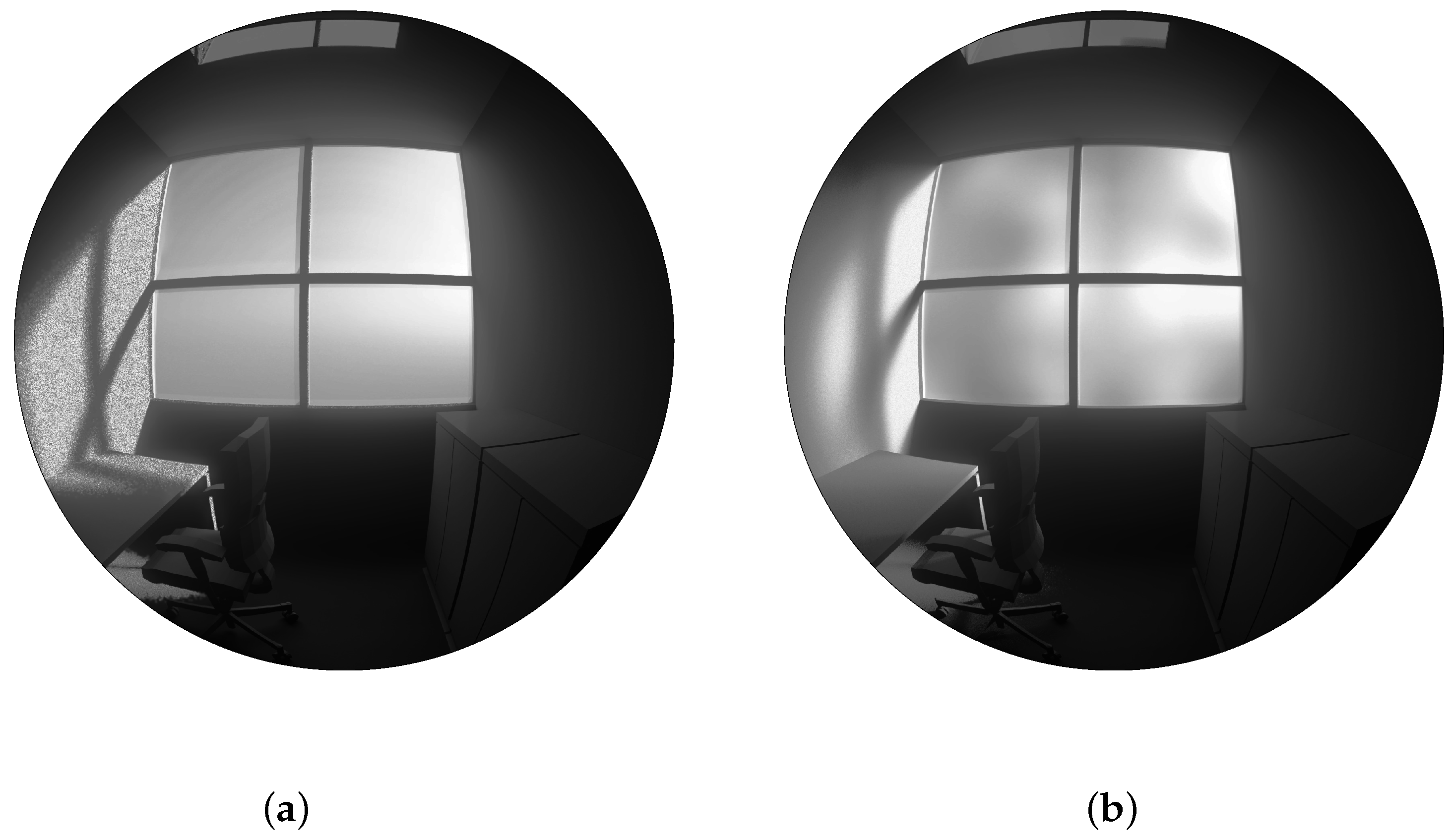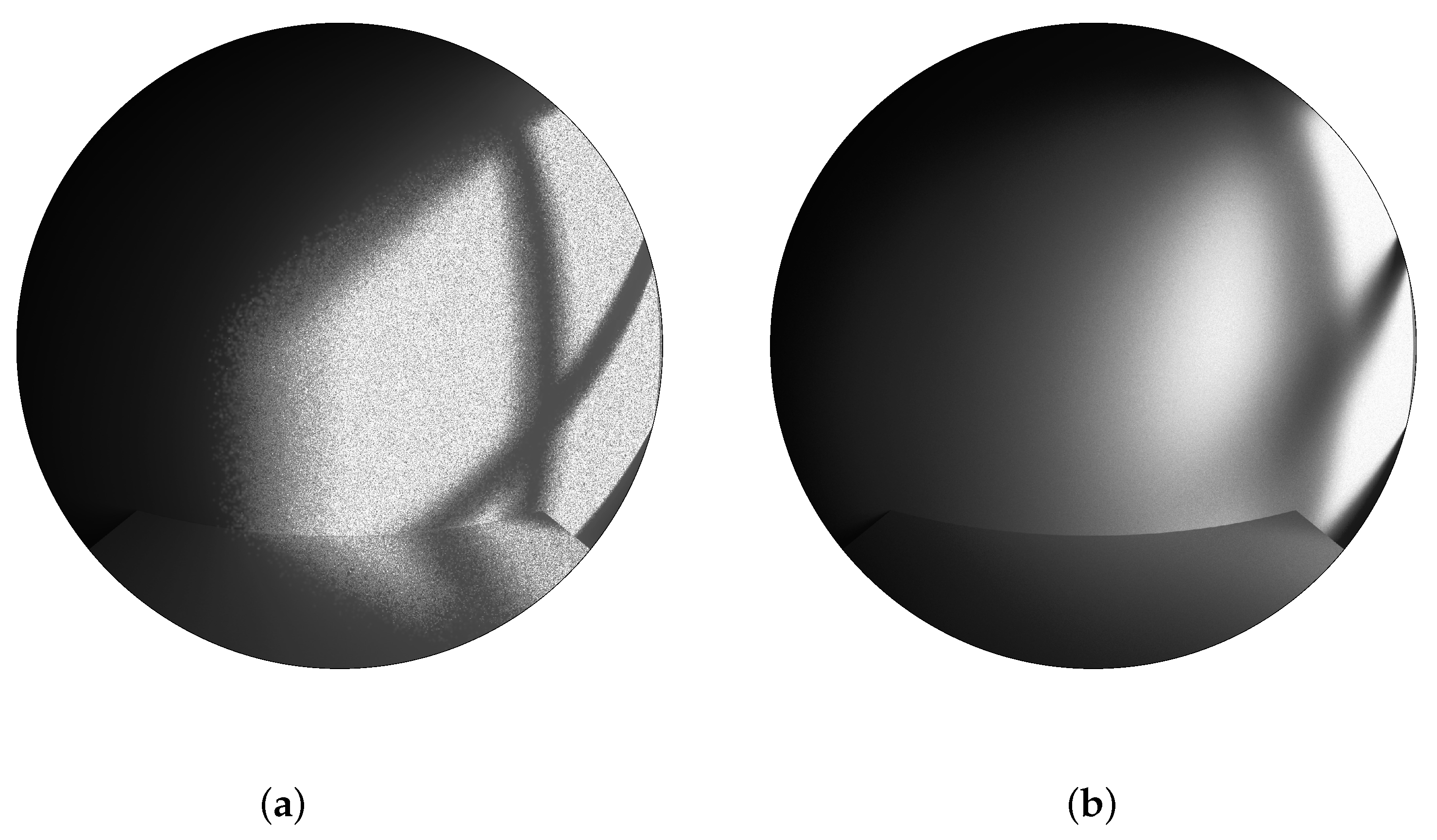Complex Fenestration Systems (CFSs) improve visual and thermal comfort by controlling the admission and distribution of daylight. They have a two-fold, beneficial effect on electrical energy demand. Operation of artificial lighting can be minimized due to the increased supply of daylight and the reduced need to operate sun-shades. Demand for cooling decreases due to lower internal gains by lighting and the control of solar gains [
1,
2,
3]. Typical CFSs comprise a set of co-planar, clear and scattering layers. These layers are chosen from a range of coated and uncoated glazing, interior or exterior sun-shades and devices for glare control, such as Venetian blinds or woven roller shades. The optical properties of a CFS result from the particular combination of its layers and includes the complex inter-reflection within the system [
4].
Daylight and building energy simulation are applied to predict the impact of CFSs on comfort conditions and energy demand [
5,
6]. For assessments of thermal comfort, models must accurately predict solar heat gain depending on the incident direction of solar irradiation [
7]. Visual comfort assessments rely on models that replicate not only the total flux, but the distribution of light into the building interior, adding the outgoing direction as a second independent variable. Models fulfilling the requirements of thermal and visual comfort assessment are established for fenestration systems comprising clear layers, such as double or triple glazing, and implemented in simulation software. CFSs comprising scattering or re-directing layers impose a particular challenge due to their almost infinite variety and the characteristic irregularity of their optical properties [
8].
1.1. Modeling Complex Fenestration Systems with Bidirectional Scattering Distribution Functions
The effect of CFSs on incident light can be expressed by their Bidirectional Scattering Distribution Functions (BSDFs). The BSDF describes light transport through a thin surface element, such as thin CFSs and their layers, for any pair of incident and scattered outgoing directions
[
9,
10]. The implicit definition of the BSDF is given by the rendering equation [
11]:
where
is the scattered outgoing,
the incident radiance and
the solid angle of the light source seen from the surface. Equation (
1) shows this simplest formulation of the BSDF depending only on incident and outgoing directions. Further variables may be introduced to resolve spatial non-uniformity or the dependence on wavelength [
12].
Analytical models for the BSDF of CFSs have been proposed, but share the limitation that they are applicable only to particular classes of systems [
13,
14]. The application of a directional basis, merging ranges of both incident and outgoing directions into patches, allows one to replace the BSDF as a continuous function by a discrete set of luminous coefficients [
15]. For each combination of one patch on the incident, and one on the outgoing hemisphere, this coefficient holds the average BSDF of all incident and outgoing directions contained by the patch. This average evaluates the bi-conical transmission, an optical property that can be directly measured using gonio-photometers [
16,
17] or computed employing analytical models or Monte Carlo ray-tracing techniques [
18,
19,
20].
1.2. Computational Combination of Bidirectional Scattering Distribution Functions
To leverage the fact that an almost infinite number of CFSs is formed by combining a limited set of available layers, measurements and the creation of libraries, such as the CGDB [
21], typically aim to characterize individual layers rather than entire system assemblies. Computational methods to combine the BSDF of one fenestration layer or a subsystem (BSDF
) with that of adjacent layers into the effective BSDF of an entire fenestration system (BSDF
) are then applied to provide models for simulation. A matrix formalism is employed in analogy to the computation of scattering on stacks of clear layers [
22]. Forward and backward reflection and transmission
form the four components of the BSDF (
Table 1) and are each represented as a matrix of
m incident and
n outgoing directions [
23,
24].
In building sciences, the matrix formalism was proposed to evaluate the absorption of light on individual layers as part of the computation of solar heat gain through CFSs [
25,
26]. The luminous coefficients
for the four component matrices are ordered such that the columns
m correspond to 145 incident and rows
n to 145 outgoing directions:
The directional basis of 145 defined directions will be referred to as the Klems basis after its inventor and is illustrated in
Figure 1a. By convention, the forward direction corresponds to incident light from the building exterior. Purely specular transmission and reflection, defined by equal incident and outgoing direction, form a special case that can be described by diagonal matrices.
The coupling of the outgoing directions of one layer to the corresponding incident directions on the next adjacent layer is implemented by a diagonal propagation matrix
Λ. Its coefficients are set to the projected solid angle of the patch represented by each coefficient
. The BSDF
of the entire system, including inter-reflection between layers, is then computed by iteratively repeating the combination of BSDF
s for pairs of layers or sub-systems
and
:
To overcome the effects of spectral averaging, the method can be applied to spectral channels and is as such implemented in W
indow [
27]. With its interfaces to various building energy simulation tools and the CGDB, this software is currently the de-facto standard for modeling of multi-layer CFSs.
1.3. Data-Driven Models of the Bidirectional Scattering Distribution Function in Daylight Simulation
Due to its general applicability, discrete representations of the BSDF have been employed in lighting simulation to model the irregular transmission through CFSs.
Distributed as part of the daylight simulation software
Radiance, mkillum evaluates BSDF data during the pre-computation of light transport through fenestration. It replaces the CFS by a virtual light-source in the diffuse-indirect inter-reflection calculation [
15]. The Klems basis comprising 145 patches is applied to both incident and outgoing directions. A modification of mkillum substitutes the Klems basis by 145 incident and 1297 outgoing directions, following a recommendation by the International Energy Agency (IEA) [
28,
29,
30]. Current versions of
Radiance support the use of data-driven models, not only in the pre-computation of virtual light sources. A data-driven reflection and transmission model allows one to describe any CFS only by a surface and its BSDF
in all phases of the simulation. The support of the Klems basis provides an interface to the CGDB as a data provider, as well as to
Window to model glazing assemblies from chosen BSDF
s. The data-driven model is in wide use especially in Climate-Based Daylight Modeling (CBDM) workflows, such as the Three-Phase Method (TPM). Shared among software tools, such as
Window,
EnergyPlus and
Radiance, the Klems basis backs a consistent modeling approach in multi-domain simulation [
31,
32].
The directional resolution of the Klems basis has been found to be sufficient in simulations aiming for illuminance-based performance metrics. However, its adequacy in the computation of imagery such as applied in the prediction of glare and visual comfort has been questioned [
33].
Radiance addresses this limitation by a refined representation of the BSDF. Rather than applying a fixed directional basis, patches are defined by mapping regions of a sub-divided square to the hemisphere. A symmetric subdivision of both axes of the square by the base of two results in
patches, with typical
to 7. An algorithm maps the boundaries of the sub-squares to directions
and leads to a set of patches of equal projected solid angle and configurable resolution
to 16384. The resulting patches are shown for two exemplary resolutions (
and
) in
Figure 1b,c. A four-dimensional tensor (dimensions relating to
) can consequently hold the
luminous coefficients for
incident and
outgoing directions of one BSDF component [
34]. An optional data-reduction pass processes the tensor into a hierarchical, four-dimensional tree structure by adapting its resolution according to the local variance of the initial set of coefficients. The adaptive resolution preserves important detail, but drastically reduces the size of the model. An interface to load, cache and query the model is provided with libBSDF as part of the open source software
Radiance. This approach to store the BSDF at configurable resolution will be referred to as the Shirley–Chiu algorithm, after the inventors of the underlying disk-to-square mapping algorithm [
35].
While both the generation of BSDFs and its application in daylight simulation at high resolution are supported in Radiance, the combination of BSDFs of adaptive resolution in analogy to the matrix formalism implemented in Window is not possible. Modeling of CFSs by the data-driven model applied to co-planar surfaces is not feasible due to the computational expense of ray-tracing. Horizontal research designs aiming to cover many different combinations of fenestration layers, as well as planners evaluating alternatives, are therefore currently limited to models of low resolution.
